Fishing rods come in all shapes and sizes, so finding the right one depends largely on a whole host of factors. What species will you be fishing for? What methods will you be using? How far will you be looking to cast? Somewhere on the market, there is a rod to suit almost every angling need.
Rods have had to advance due to the surge in specialised methods in recent times, whether that's method feeder fishing, pellet waggler fishing, or bomb fishing, the list really is endless. Whilst using a feeder rod for float fishing is possible, it's far more effective using a rod that is built for a job, and it will make the process far more efficient and enjoyable. Similarly, if you need to cast a method feeder over 70m, a 9ft, light feeder rod will be useless in that situation, but it will excel in swims less than 20m wide.
The best fishing rods at a glance:
In this guide, we will take a look at some of the best fishing rods available for specific needs like carp fishing, feeder fishing and float fishing, as well as sharing an insight into what to look for when buying a fishing rod for the first time.
How we test the best fishing rods
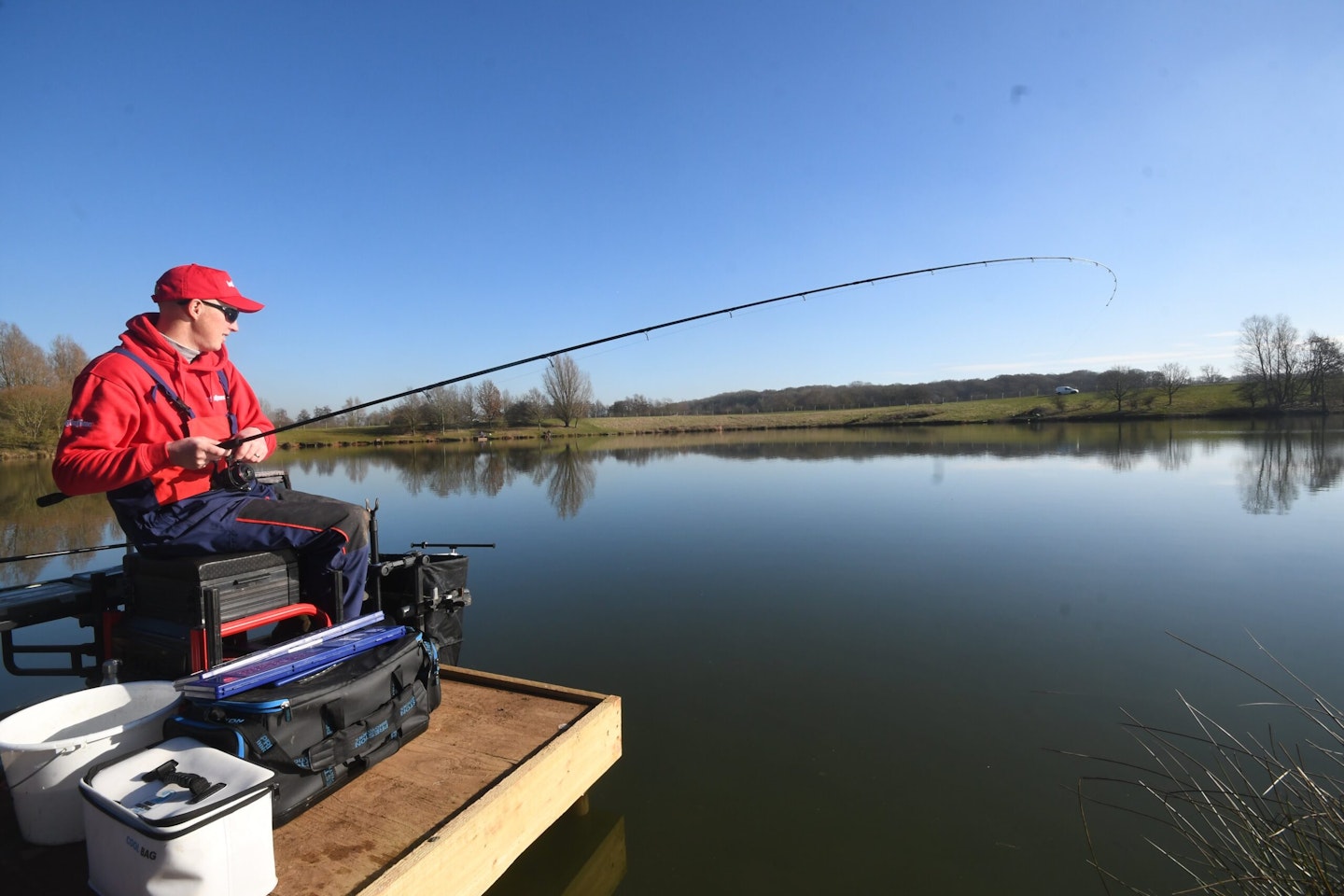
These fishing rods have been tested by experienced members of the Angling times team. The rods in this guide are the best in their category, so while not the cheapest you are certainly getting the best you can buy.
Team members, Mark Sawyer, Tony Grigorjevs, Aidan Bordiuk and Dan Webb have been testing a variety of rods, on venues across the country for almost every species imaginable, and they have been compared with rods of a similar calibre before making this list! Whether you want to catch big carp, tench on the float, bream on a feeder or barbel from big rivers, this guide has you covered!
Our decision process of what makes the best fishing takes into account various factors including price point, build quality, action and usability to ensure we can give you the best advice on factors that will make an actual different to your angling, and catch you more fish, regardless of species.
The following list includes a mixture of our all-time favourites fishing rods. Find out how we test our gear, HERE.
If you are looking for a sublime feeder rod for your commercial fishing, you have found it in the Drennan Acolyte Commercial Feeder, we can't praise it enough.
It might not be quite as good at showing tentative roach bites or sweeping skimmer takes, but the reduced recoil will stop it breaking when committing to fishing for bigger fish with repeated casting and reeling.
All this sounds great, but I was still a little shocked when I took one of the rods out of the bag.
Acolyte rods boast possibly the thinnest blanks on the market, and the Commercials are no exception. In fact, the thickest part of the longest 12ft model is near half the diameter of a five-pence piece!
Combine this with the oversized guides that we are more used to seeing on distance rods, and you get a very unusual look. It almost tricks your eyes with its unexpected proportions. This illusion only becomes more dramatic the shorter the rod you look at.
However, I needn't have worried about its capabilities, as this sensationally thin blank absorbed every movement of really big fish with ease, while still allowing me to feel exactly what was going on.
Despite being short and soft, with a progressive action, the 10ft model has a stunning casting potential, even more unexpected considering the super-thin blank.
Casts nearing 50m were easily achievable, the sort of range I would normally pick an 11ft rod up for. This now nicely categorised the rods for me – 9ft for small commercials, 10ft for big commercials.
Although tweaked to favour flatbed feeders and bombs, all these rods can, of course, be used with conventional feeders for silvers, F1s and on natural venues – they just won’t do it quite as well as the correct dedicated Drennan Acolyte.
So, will my beloved 11ft Medium Feeder finally be retired? Yes, it will, but unexpectedly its replacement will be the shorter 10ft-long Acolyte Commercial. It really is that good!
Pros
- Fantastic rod for commercial feeder fishing
- Versatile rod, built for use on variety of venues
- Great casting rod
Cons
- Not the best rod if you are primarily targeting silverfish
| Casting weight: | 30g |
| Tips supplied: | Carbon 1oz, 1.5oz and 2oz |
We don't all have hundreds to spend on a fishing rod, but that doesn't mean you can't get a quality rod on a budget as the Guru A-Class range has proven. With four distinct models, the Guru A-Class offers something for every angler. It includes three 2-piece rods designed for commercial pellet waggler fishing and a versatile 3-piece 13ft model suitable for all styles of float fishing. They have really impressed us against rods costing a lot more, and we find ourselves using them more and more often!
Crafted from 24T tensile carbon blanks, these rods strike the perfect balance between strength and flexibility. The stainless frame guides feature durable titanium oxide rings, minimising line friction and enhancing your casting performance.
The standout model, the 13ft Pellet Waggler, weighs just 180g and handles a line rating of 2-8lb with a casting weight of 3-15g. This rod is perfect for targeting carp and F1s in commercial fisheries as well as silvers on natural venues. If you want a good quality rod that will do a bit of everything without breaking the bank, look no further!
A comfortable rod that feels like a natural extension of your hand. The downlocking DPS style reel seat and cork handle provide a secure grip, allowing for maximum control.
Pros
- Capable and versatile rod
- Equally at home on stillwaters as rivers
Cons
- May be a little too heavy for some silverfish anglers
Best distance casting carp rod
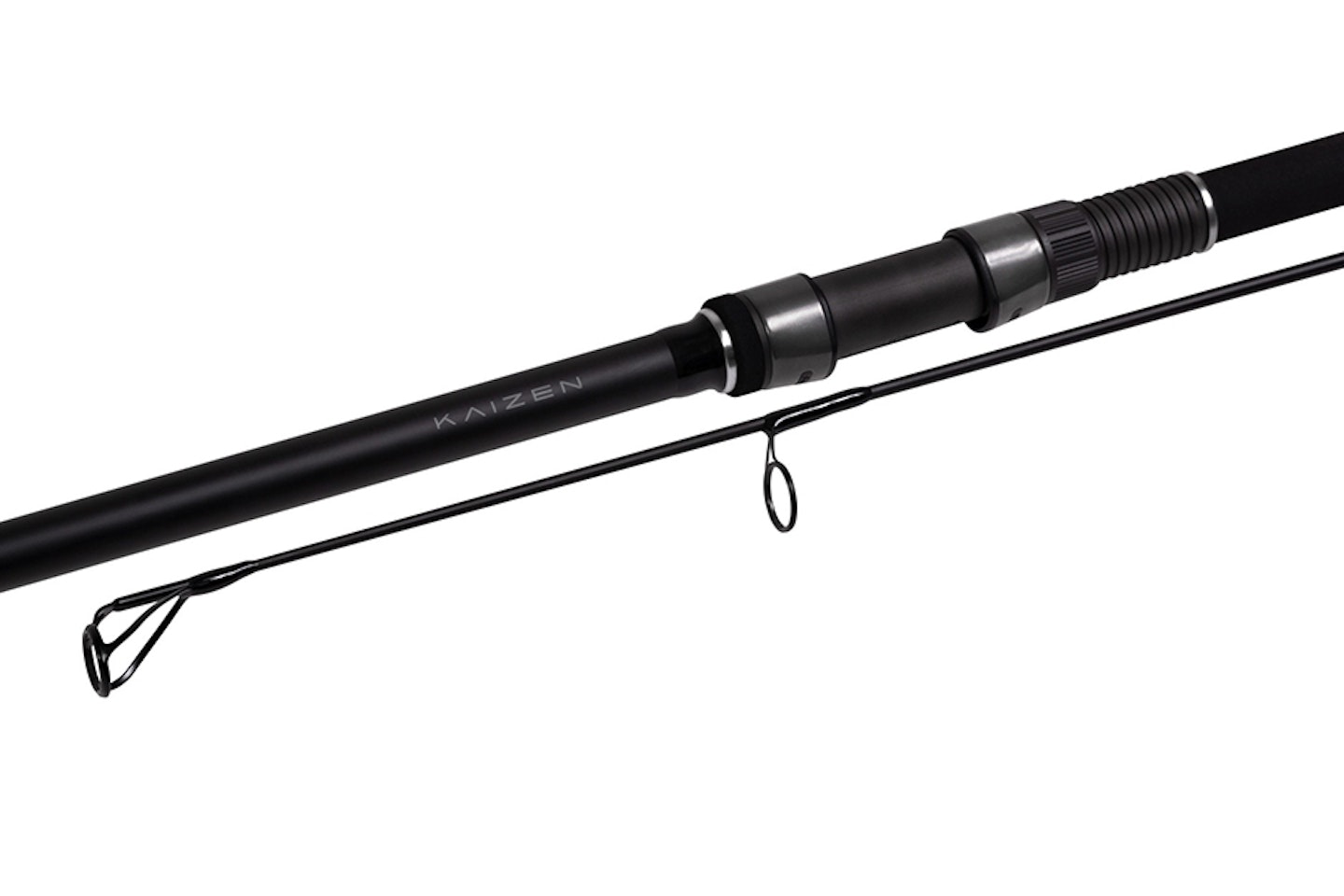
www.total-fishing-tackle.com
If you are looking for a new set of carp fishing rods, look no further than the Korda Kaizen Platinum Carp Rods. Available in test curves between 3lb and 4lb and lengths of 12ft, 12ft 6ins and 13ft, these rods will help you hit your long distances with ease, in fact we found they added at least 10 yards our cast without any change in technique!. They’re Korda’s first entry into the rod market, and they do not dissapoint.
Constructed from a high-grade, super tensile Japanese carbon with a fast-tapered profile blank, the rods have a high compression strength, so you can put your back into those long chucks without the fear of them snapping under the strain! What is nice is, with the exception of the 4lb TC rods which do dampen the fight a little as you would except, the fish playing action is lovely on these rods, despite them being distance casting tools in the main. Korda have struck a great balance between getting your leads out over 100 yards without sacrificing too much of the action, which we commend them for!
They boast a super-fast recovery speed and are super light thanks to the stainless-steel guides, which include a 50mm butt and 16mm tip ring on all models. There’s a dedicated spod rod too.
Pros
- Incredible casting tools.
- Classy, low-glare matt paint finish and clean fittings.
Cons
- We would have liked to have seen a slightly lighter rod in the range for smaller waters.
If you enjoy a days trotting, then the Drenann Acolyte Ultra range of rods are seriously hard to beat. There is probably not a rod on the market that is lighter than they are, making them easy to hold and use all day without any fatigue in your arm. Believe us when we say, these rods are truly outstanding for holding all day!
The tips of the rods are incredibly fast too, which will help you hit even the most sensitive bites, great if you fish for roach on commercials or like to long trot on rivers, put simply you will catch more fish because of this rod.
The new Acolyte has larger, better-casting guides lower down, with a modern top-end Fuji screw-down reel seat, and breaks down into two or three sections depending on model. It also feels stiffer when being waggled around than previous models, something several anglers have mentioned to me after looking at them in shops. This, however, is an illusion created by the tippy action and the crisp modern carbon used – with a fish attached, it feels so much softer.
This tweak just adds to an already incredible series of rods as the Ultra casts beautifully, as well as being unbelievably light and well balanced to hold, and felt lightning-fast when striking at bites.
The finesse of the rod allows you to use much finer tackle, so if you hook a bonus fish like I did in testing on a tiny size 20 hook and a 0.10mm bottom, I was still able to land them, albeit with a little patience.
When a fast and firm strike into a fish of that size on gear that light didn’t result in a breakage, I knew that the my old waggler rods had been used for the very last time, and I had to think of some excuses to give the wife as to why I was going to be buying yet another rod!
Pros
- Lightweight, crisp, and responsive
- Instantaneous line pick up
Cons
- Not suitable for big floats and commercial carp
Designed for anglers who prioritise distance casting and power, the Daiwa N'Zon Distance Special rods were developed over 12 months to offer exceptional performance and versatility.
Featuring X45 and HVF nanoplus construction the Daiwa N'Zon Distance Special rods provide the necessary strength and power for long-distance casting. The V-Joint ensures smooth and controlled action, while the SeaGuide stainless steel anti-tangle guides reduce wind knots and tangles.
The Daiwa N'Zon Distance Special rods are available in a range of lengths, from 11ft to 14ft, to cater to different casting distances and fishing situations.
You can watch Mark give his full verdict on our YouTube Channel, here!
Pros
- Specifically built for using to cast long distances
- Despite being built for distance, it remains responsive and forgiving
Cons
- Would have liked to have had Daiwa's long distance tips supplied with this rod
If you love Pellet Waggler fishing and want a rod that matches your enthusiasm, then you need look no further than the Preston Supera X Pellet Waggler rod. While we appreciate it isn't the cheapest rod for a dedicated tactic, this rod is simply perfect for chucking larger wagglers and catching bigger than average carp.
On test with this lovely rod each cast was hard and fast, the float feathered to what felt like perfection with the smallest of plops, and the line stayed as tight as possible. Each bite was met with a flash of the rod, which tore the line out of the water in the hope of feeling solid resistance on hitting the float. In two hours, I’d managed to hit five of the eight bites, and fish of near double figures came to the net.
The pellet waggler might not be the out-and-out bagging method it once was, but it is still essential to the commercial match angler, and a highly rewarding way of fishing to the pleasure angler too – once you get it right, of course! One thing I did appreciate was the flattened handle, when you have already caught a number of hard fighting carp, this really helps keep you in control and stops its slipping out as your arms get tired.
The Supera X 11ft Pellet Waggler made the whole experience just that bit more enjoyable, and allowed me to get the very best that I could from the tactic.
You can read our full Preston Supera X Pellet Waggler review here.
Pros
- Flattened handle really helps
- Superb rod for the pellet waggler
- Lightning fast tip speed
Cons
- A little stiff for general waggler fishing
The Daiwa Matchman Mini Method is a gem of a rod. After carefully looking over the minimalistic ceramic-lined stainless steel guides, screw down cork reel seat with cork handle and EVA lower, all appeared to be what I’d expect for a sub-£100 rod, let alone a sub £50 one.
In fact, the mini Method Feeder rod was indiscernible from many high-end rods just from a mere inspection and a waggle. It was at this point that the names troubled me a little, as pigeonholing these rods into a ‘Method Feeder’ category is a shame, as the range would make ideal all-round feeder rod for any kind of venue, not just commercials.
Another observation was the unusual finish. The butt section of each rod has a smooth matt finish, while the upper sections are raw carbon. After a spot of investigation, I learned that the finish stiffens up the lower section, while weight is reduced higher up the blank by its exclusion. This two-part look is a little unusual, but if it delivers greater performance then I’m all for it.
In use, the rod felt light and forgiving in the hand, and while displaying a formidable bend, the rod still didn’t feel underpowered at any point, even with the fish I was hooking, which must have been averaging 8lb.
In short, the rod felt glorious, the only issue being that I still hadn’t been able to fault it in any way. Even as the day progressed and I made bigger casts, I was blown away by the smooth action and fast recovery.
As for my final thoughts on the range? Well, if you only have £50 to spend on a rod, then you’re hardly likely to find anything better when it comes to the longer rods. As for the 9ft Mini Method Feeder, though, I’m not fussed if your budget is £50 or £500, this rod is worth a look!
Read our full Daiwa Matchman 9ft Mini Method review.
Pros
- Lovely fish playing action
- Perfect for commercials
Cons
- Will struggle to cast a larger feeder any distance
| Casting weight: | 30g |
| Tips supplied: | Carbon 1oz and 1.5oz |
Short carp rods have boomed in popularity in recent years, and one of the best examples is the Sonik Xtractor Pro Carp Rods. Not only are they available in lengths of 6ft, 9ft and 10ft and a range of test curves, but they retract allowing them to pack down to fit in the boot of your car with ease. In fact, I have a couple I leave in my boot during the summer in case I get an hour or two to sneak out stalking carp on any of the local lakes. How many times have you found fish feeding with no gear at hand, It is amazing how many more fish you catch having these rods with you all the time!
Not only are they incredibly convenient, but they are built from quality stuff too, although some smaller rods are considered cheaper quality, and you would be right in some instances these certainly aren't that! They are as tough as old boots, which is great as lets be honest they are going to be subjected to some abuse laying on the ground, hitting branches and brambles and getting smothered in the latest wonder liquid. If anything, they relish this environment.
If you are new to carp fishing, want an extra set to use like we do at a moments notice or just prefer shorter rods for boat fishing, you need to seriously consider the Xtractor Pro's!
Pros
- A lot of bang for your buck
- Superb high-quality fittings
- Great for convenience and beginners
Cons
- Restricted casting distances
Best waggler rod for silvers (2024 National Angling Awards Winner)
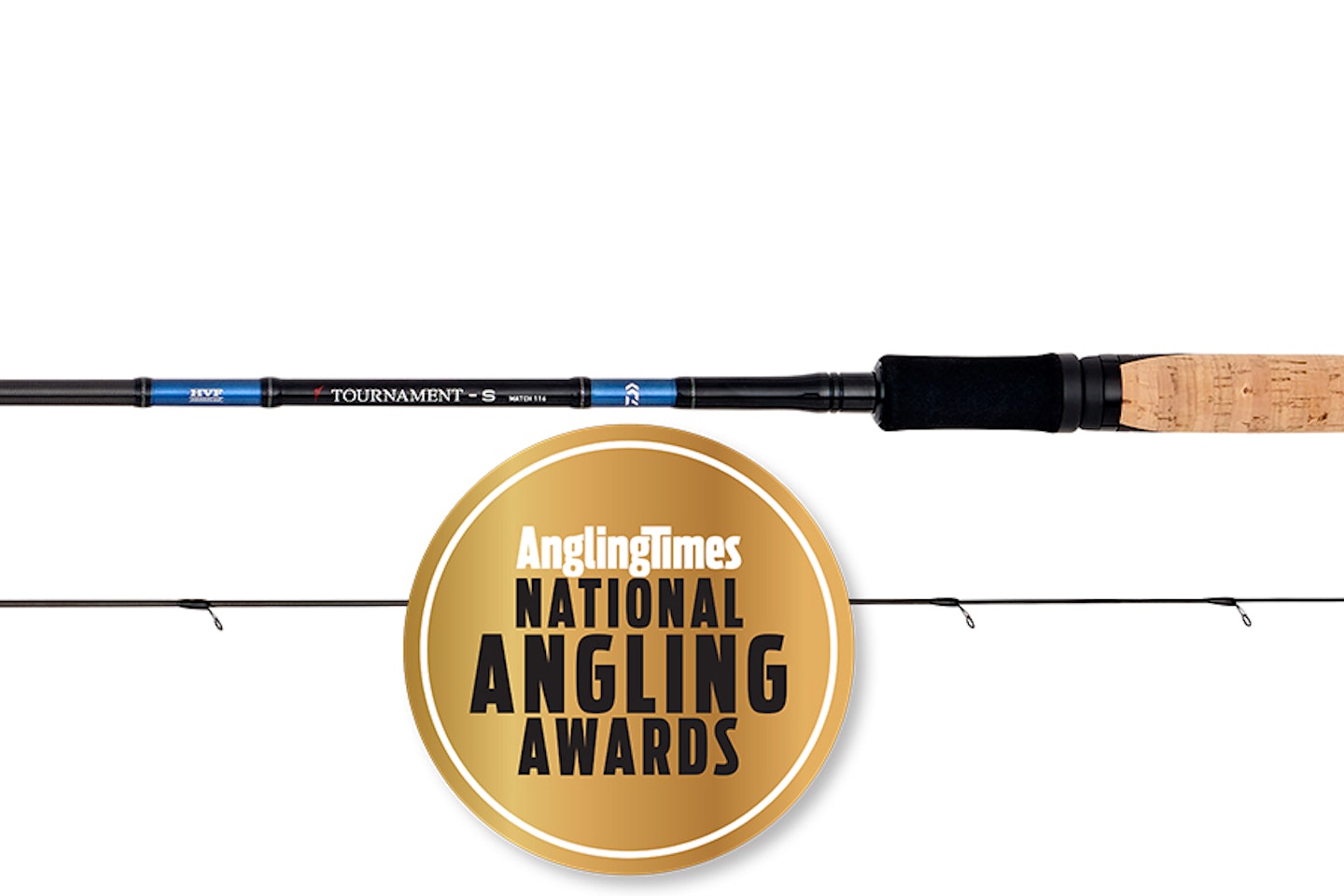
www.total-fishing-tackle.com
The newest incarnation of the legendary range is the Daiwa Tournament S 11ft 6ins Float. It has been updated with Daiwa’s latest technologies, including HVF Nanoplus and V-Joint Alpha, but more notably, the action has been geared slightly more towards natural venue fishing. It is so good in fact, it won best float rod in our National Angling Awards!
The 11ft 6ins Float is a superb offering, brought about by the rise in winter silverfish matches on commercials, along with the need to serve anglers fishing small rivers and drains, making it already the best- selling float rod in the range. Perfect for smaller wagglers and casts of 15m to 25m, it will also cope with F1s or carp on mugging tactics if required.
Seaguide TYG and TDG, premium skeletal guides are used throughout and perfectly complement the fast, yet forgiving action of the rod’s gorgeously thin blank.
Pros
- An awesome rod for more traditional waggler fishing techniques
- Lightning fast line pick up
Cons
- Not our first choice if big carp are the target
Best value specimen rod
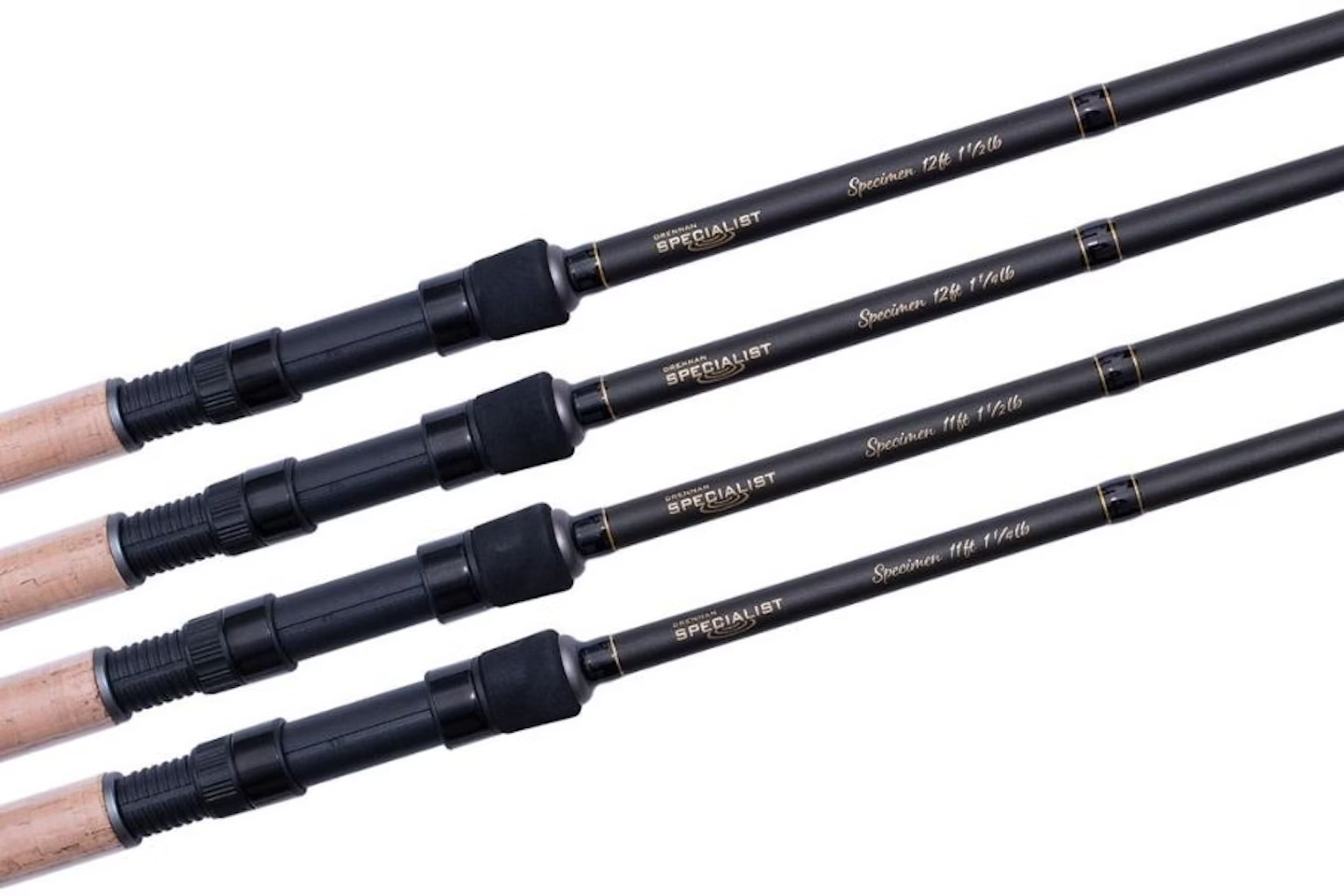
www.total-fishing-tackle.com
For the specimen anglers seeking a rod suitable for various species and techniques, the Drennan Specialist Specimen Rods are a perfect choice. Available in lengths of 11ft and 12ft, with test curves of 1¼lb and 1½lb, there is a rod for everyone, whether you want to target smaller specimens like roach, rudd and perch or fishing for larger specimens like chub, tench, or bream.
The 11ft and 12ft models with a 1¼lb test curve are perfect for smaller species such as roach, rudd, and perch. If you like to catch species like tench on the float, these rods have all the power to land them, without taking the fun out of the fight, and as usual with Drennan, the rods look superb!
For anglers targeting specimen sized chub, barbel, tench, and bream, the 1½lb models are also available in 11ft and 12ft lengths. These versions come with slightly larger diameter guides that improve both casting distance and accuracy, as often these fish can sit further out in the lake, especially on pressured venues.
Pros
- Large guides for better casting
- Choice of length and T/C to suit
- A great rod for catching tench on the float
Cons
- Would like to see a 1.75lb option to round out the range
Best Barbel Rod
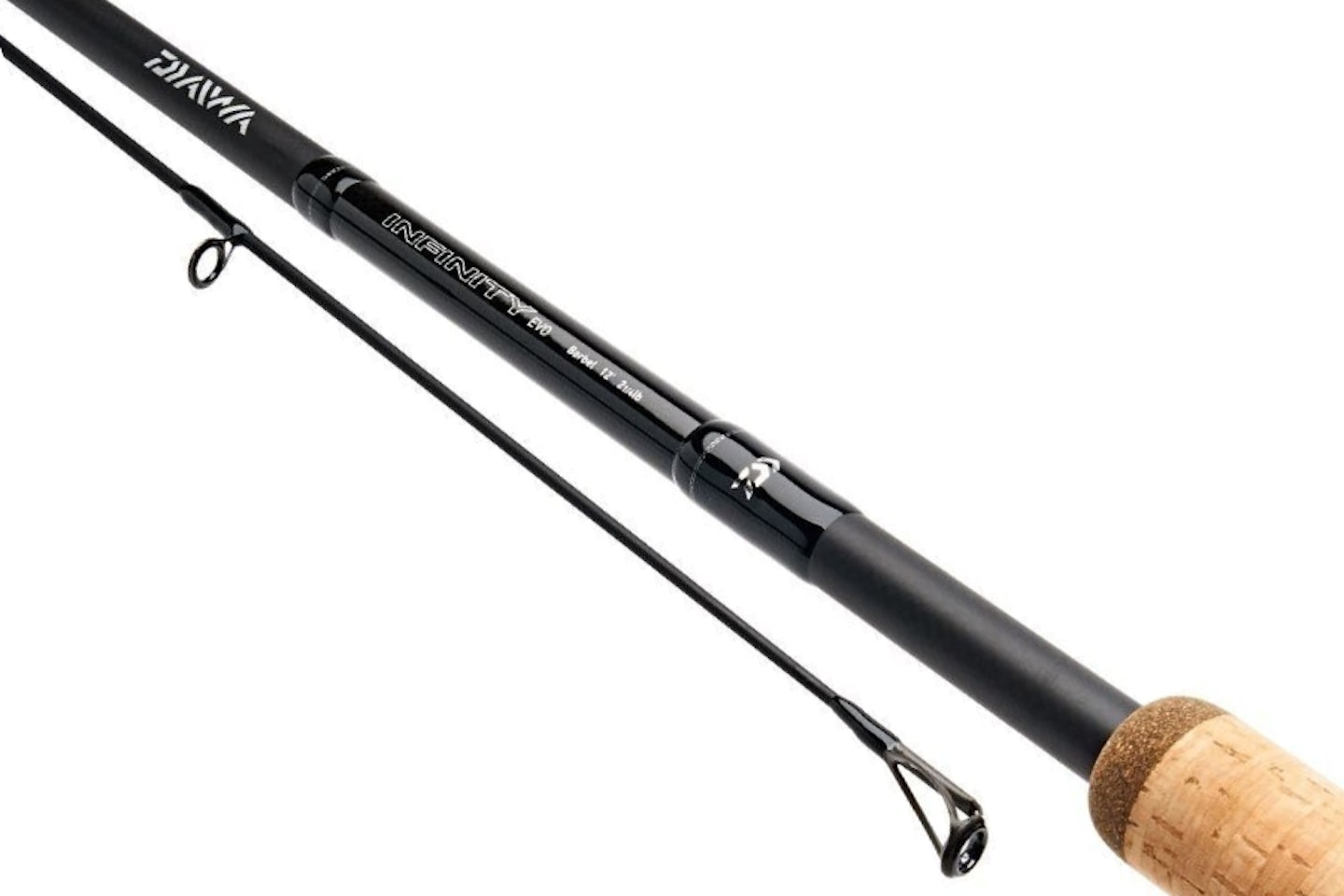
www.total-fishing-tackle.com
If you enjoy chasing the prince of the river, you’ll be hard pushed to find anything better than the Daiwa Infinity EVO Barbel rod. Whether you want to roll baits on smaller streams, lower a piece of meat under a snag or cast the largest feeders on the most powerful rivers like the Trent, this rod really can do it all.
Built on the quality, high volume carbon blank makes for an incredibly slim, lightweight rod that, in the 2.75lb version, will cast 5-8oz with ease and precision and has been designed to land the biggest of barbel. The Fuji reel seat allows the rod to bend all the way to the butt cap, utilising all the power available, which, when combined with the armlock handle, helps to subdue even the hardest fighting barbel effortlessly.
The 1K woven blank is fitted with Fuji rings with SiC guides that are very hardwearing to provide you with a rod that looks fantastic now and will continue to perform for years to come. These rods are also available in 1.75lb and 2.25lb models, both in 12ft.
Pros
- Capable of performing on any UK river.
- Lightweight, powerful and durable.
Cons
- Not as light as some rods.
What should you look for when choosing a fishing rod?
There are literally hundreds of different fishing rods on the market at the moment and it can be confusing which is the best rod for you. To break it down simply, decide what style of angling you would like to do first as this will narrow down the choice, granted there are some crossovers, but in the main rods are built for specific tactics.
If you are thinking of fishing with a Method feeder on a commercial, a short feeder rod would be a great starting point, similarly any style of pellet waggler or float rod in the 11-13ft range would be great for float fishing on these kind of stillwaters. If you favour rivers, we would suggest a float rod with a minimum length of 13ft upto 15ft to give you better control, any longer can become a little cumbersome, especially if you are new to the rivers.
If carp fishing is more to your liking it really depends on size of venue and size of fish. If you fish big venues, a 12ft rod in a 3.25lb-3.5lb is a very popular choice as strikes a nice balance between casting ability and fish playing action, anymore and the stiffness in the rod can cause hook pulls. If you prefer short sessions and stalking, there are some great short options from 6ft-10ft that are great for a few hours fishing.
Glossary
Blank: The hollow carbon fibre tube that the rod is made from, attached to which are the guides and handle.
Guides: The rings that line the length of the rod that the line passes through.
Reel Seat: The part of the handle that your reelattaches to. Almost all UK coarse rods have screw-down reel seats, where the fore-grip on the handle rotates and closes the seat to hold the reel in place.
Test Curve: Usually measured in pounds, it's the weight that needs to be applied to the end of the rod to make it bend over 90 degrees. The greater the test curve, the more powerful the rod.
Casting Weight: Depending on the manufacturer, it is either the best suited or maximum total weight in grams that you should cast with your rod. You will normally find your rod will perform best at around half its total casting weight. E.g. a 120g feeder rod best suits a 60g feeder.
Quiver tip: The very top (often brightly coloured) section of a feeder rod, used to identify bites, which bends and 'quivers' when a fish moves off with the bait. Like the test curve of a rod, quiver tips are often rated in test curves measured in ounces.
Fish playing action: A way of describing how good a rod performs when reeling in a fish. A rod with a good fish-playing action will provide plenty of cushion to a thrashing fish, preventing hook pulls (lost fish) and line breakages.
Progressive Action. A rod that quickly powers up from its tip through to its middle area, providing the ideal coordinated playing action for powerful fish.
Tip action: This normally applies to traditional three-piece float rods that need a 'tip or tippy action' to be able to whip out light floats when casting, as well as pick-up line very quickly on the strike.
Through action: A rod that has a softer top section but still produces a cushioned bend throughout its entire length, giving a good fish-playing action.
Parabolic Action: A rod that can bend throughout its length but stiffens towards its butt section, providing a controlled cushioning action when playing a fish.
Rod taper: How a rod changes in diameter along its length. A fast taper rod will typically thicken up very quickly as you move away from the tip. Although other factors come into play, like carbon types, weave and construction, typically, a fast taper rod will bend more at the tip than the butt (tip actioned).
Fishing rod FAQs
Why are rods different lengths?
Typically, the further you want to cast, the longer the rod you should go for, whilst also taking into account casting weight and fish-playing action.
Should I choose a rod that will cast the furthest distance that I will want to fish?
No, you should choose a rod that best suits the distance that you want to fish at. A rod that is too long and powerful will make casting short distances with any kind of accuracy difficult and will have a poor fish-playing action. This is why all rod ranges feature models of varying lengths and powers.
Should I choose a cork or EVA handled rod?
This all comes down to personal preference. Cork is lightweight, transmits more feeling to your hands when playing a fish and looks great. EVA, however, is cheaper and more durable. Many rods have an abbreviated or combined cork/EVA handle, with the material best suited to a particular part of the handle used to give the best of both worlds.
Will a rod with a bigger casting weight or test curve rating cast further?
Yes, when combined with extra length, you will be able to achieve greater distances with the correct technique and a weight that matches the rod. Be aware that the more powerful your rod, the stronger the line and hooks you will need to use to prevent fish losses, which could, in turn, mean you fooling less fish into taking your bait to start off with.
What quiver tip should I use?
The tip should not only match the species and type of bite you are expecting but, more importantly, the tow and movement on the water. Selecting too light a tip will see it bend round too much due to the flow of water pulling on the line, making seeing bites difficult. Too stiff a tip will see fish dropping the bait due to the extra resistance, and shy bites hard to see. This is why most feeder rods come with several different rated quiver tips.
Can I use the same rod for both float a feeder fishing?
Not normally with float or feeder rods, but you can with more lighter test curved Specimen style rods. Some of these will come with both quiver tips for ledgering and a separate hollow top for float fishing.
What is the difference between a pellet waggler rod and a standard float rod?
Often shorter in length at 11ft or less with a little more power, pellet waggler rods are suited to busy fishing and frequent casting when fishing up the water for carp with heavier floats and lines. 13ft is the most popular length with a float rod which gives you greater control over lighter floats and a softer action for smaller hooks, baits and species.
What is the difference between a Method feeder rod and a standard feeder rod?
With some manufacturers, there is no difference at all, whilst others provide heavier quiver tips and more powerful fish-playing actions. Generally speaking, you can use a feeder rod with any kind of feeder or bomb.
What are the weight guides on spinning rods for?
The numbers that are always in grams (gr) on all lure-type rods represent the minimum and maximum casting weights (lures) the blank can cope with
Why are distance-casting feeder rods so stiff?
You can cast miles with this rod, yet it doesn't feel like a broom handle to fish with. The stiffness of all distance feeder rods works in two ways. Firstly it helps to produce lots of casting power, and secondly, it minimises tip recoil aiding casting distance.
Why do anglers use telescopic carp rods?
More and more carp anglers are demanding ultra-lightweight portable rod and reel set-ups that can be stored and transported quickly and easily to the bank. They also suit smaller, more intimate waters- where short rods make getting in and out tight spots easier.
Why do float rods come in some many different lengths?
Float rods, as their name suggests, are designed and built to cast lightweight floats of all shapes and sizes, and to that end, they all serve exactly the same function. The length variations come about as float rods that are, for instance, power float rods commonly used on rivers, will have longer lengths of line to pick up when mending or striking, plus they also require a longer rod length for additional float control in flowing water. Commercial pellet waggler rods are generally used to cast heavier floats, and they are built with progressive rather than tippy fish-playing actions, which are functions best served with shorter-length rods.
What's the difference between a commercial feeder rod and an all-round or natural venue feeder rod?
Most commercial fishery feeder rods are designed with a progressive fish playing that bends at the tip and 'powers up' along the blank as more pressure is exerted, and ideal for carp. All-round feeder rods tend to have softer 'through' or 'cushioned parabolic' fish playing actions ideal for all species of silver fish.
Why would anyone need a 9ft Feeder rod?
They are perfect for use in parrot cage pegs and on venues that don't require long casts but demand pinpoints casting accuracy.
Why do so many pellet waggler rods have short handles?
What are rod test curves, and what do they mean?
Quite simply, it is the weight required to pull a rod tip to a 90-degree angle to the rod butt when the rod is held in an upright position. They can also be used as a rough rule-of-thumb guide for the rods weight casting potential.
Author Dan Webb first became involved in angling journalism in 2015 and has worked as Tackle Tester at Angling Times since April 2021. He is a fanatical all-round match angler and former England Youth International.





































